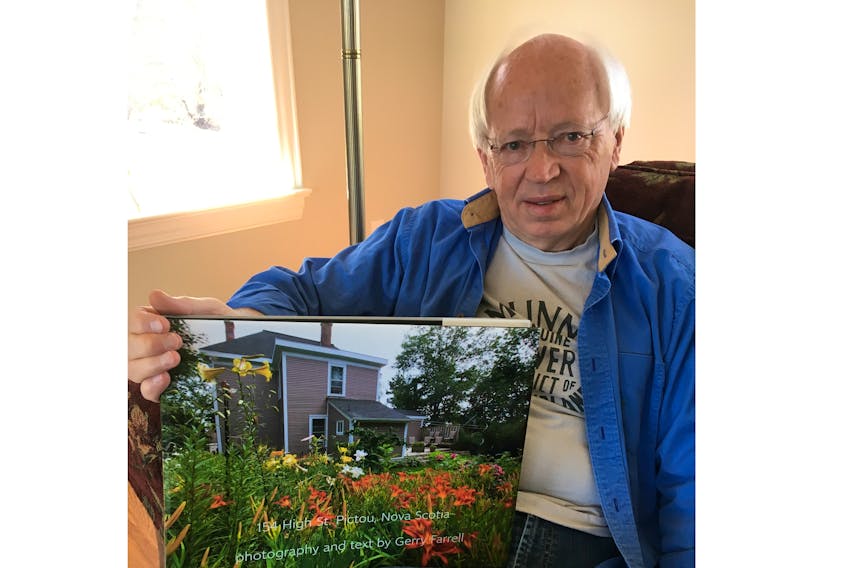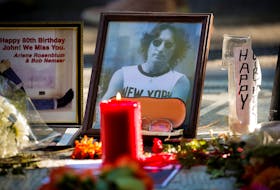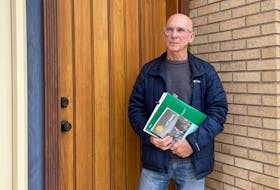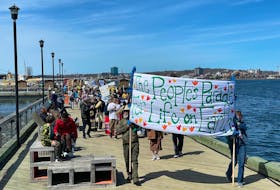Big sky shots of Pictou’s colourful waterfront, fishing ports and farm fields are Dr. Gerry Farrell’s specialty these days.
A mostly retired physician, who began practicing family medicine and later switched to the emerging field of palliative care, he remains an active supporter of Aberdeen Hospital’s palliative care program. He also fills in at other palliative care units across the province to give regular physicians time off.
“It is a small pool of physicians working in palliative care and I appreciate the opportunity to keep a hand in, particularly locally,” he said.
A Newfoundland native, Farrell believes everyone benefits from a few hobbies and his include photography, gardening, cooking and reading. His interest in photography goes back to his studies in X-ray technology, a field he entered after a year as a teenage teacher and principal, working on a probationary licence on the island’s west coast.
“I didn’t feel I had much to offer students so I enrolled in a two-and-a-half year X-ray technology program which led me to cameras and photography.”
His first job was in central Newfoundland where a senior physician took an interest in him, strongly encouraging him to study medicine.
“My family thought I had a good job and wondered what I was thinking,” admitted Farrell, who was raised near Marystown in a fishing family that had neither electricity nor indoor plumbing until after he had left home.
When he applied to enter the science faculty at Memorial University it was quickly pointed out he lacked courses in chemistry, physics and biology.
“All I had was general science which is all that was taught in my school. They told me I’d have to take a foundation year. That was a problem because I had so little money I certainly couldn’t afford a foundation year.”
The university president took a chance on him and he worked to catch up to classmates.
“I got another break in my second year when I was accepted into medicine without a science degree.”
At the time MUN had a pilot project to accept two students directly into its new faculty of medicine and Farrell became one of them.
“I wasn’t brilliant, but I worked hard. With no money I knew enough to take any break I got.”
At 26, he began practicing family medicine in Grand Bank, on the southern tip of Newfoundland’s Burin Peninsula, working with Dr. Rod Stevenson who later came to practice in Pictou County.
“In Grand Bank you were the GP, the obstetrician, the anesthetist. We were 250 miles from the nearest referral centre, had no backup and worked all hours.”
The dream was to get to the mainland where there was greater proximity to specialists, more amenities and better hours. Stevenson went first.
“I planned to go to Dalhousie and specialize in obstetrics, but I changed my mind at the last minute, realizing I didn’t want to give up family practice. I was already in Nova Scotia so I went to visit Rod who was practicing in Westville.”
The Farrells might have followed friends who had gone to British Columbia but there was an opening for a family doctor in Pictou. Farrell and wife, Vivian, who comes from the St. Anthony area of the Great Northern Peninsula, jumped at the opportunity.
“Neither of us came from much so Pictou looked like a good place to raise a family and it was. We’ve been here since 1981 and it is home.”
The stately old home the Farrells bought inspired him to start gardening which led to years of striking garden photos, including vibrant examples of macro photography which shows subjects as larger than life.
“Coming from Newfoundland where we were lucky to grow potatoes, turnips and few cabbages, it seemed to me you could throw anything at the ground and it grew.”
In a twist of irony, Farrell’s interest in palliative care was ignited by a late-night baby call.
“Just after delivering the baby I was asked to go down the hall to see a woman who was dying and suffering greatly. I’d been with dying patients before, but it struck me there was so much we didn’t know about dying and such a need to learn.”
Farrell began studying the work of British palliative care pioneer Dr. Cicely Saunders and visited London where she had opened St. Christopher’s Hospice in the 1960s.
“I also met with a doctor in Toronto who was developing palliative care but there was no formal training program at the time. I’m happy to say there is now a residency in palliative care.”
An in-home palliative care program was developed through the Aberdeen Hospital and a few years later a unit opened within the hospital.
“In the beginning I can’t say I had a great forward vision for the program, but I knew people were dying badly and families knew it, too. From the start the community showed tremendous support for palliative care which allowed us to identify needs and add services.”
Farrell believes the program has brought great comfort to the dying and their families.
“The need is only growing with an aging population and people living longer with cancer and other illnesses. Today families are geographically scattered and not always able to participate in care. Currently our resources are stretched to manage the caseload we have.”
Farrell delayed his own retirement a year to allow Dr. Anne Kwasnik, formerly a family doctor in New Glasgow, to take training in palliative care.
“We’ve always had an amazing palliative care team of really dedicated people, so it was important to me that we get the best possible person to carry on in my position. It took a while, but we found that person.”
With more free time, Farrell has continued to rise early, often setting out with fellow photographers George Sutherland and Ray Strickland, to catch the changing morning light.
“For the last 10 years or so I’ve concentrated mainly on landscape photography. I enjoy the seashore in any weather and I always bring a camera when I go to Newfoundland.”
At a recent fundraiser for Tearmann House one of his large framed photographs of fishing boats tied up at Caribou wharf was among the first prizes claimed.
“It is very satisfying to be able to offer something that is going to help Tearmann House, particularly as my wife is involved there,” he said.
Satisfying is also the word he uses in reflecting on his years in palliative care.
“You very much had the feeling you were doing something useful and helpful. It may not be the field for everyone, but I found it very satisfying.
Rosalie MacEachern is a Stellarton resident and freelance writer. She seeks out people who work behind the scenes on hobbies or jobs that they love the most. If you know someone you think she should profile in an upcoming article, she can be reached at [email protected]








